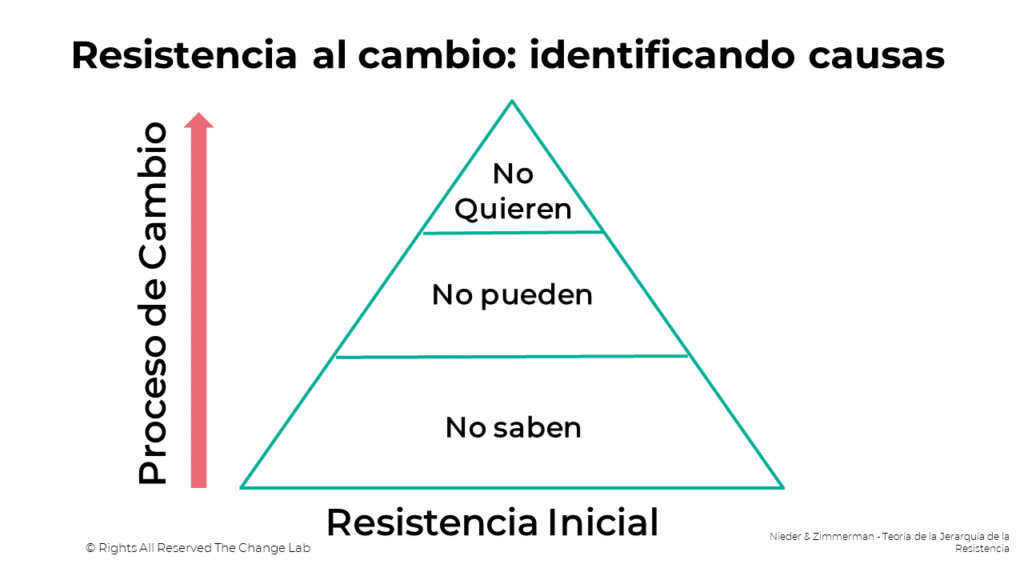Resistance to Change: I don't know, I can't or I don't want to?
Surely you have heard on more than one occasion about the phenomenon of "resistance to change", haven't you?
And you may have asked yourself on several occasions:
What is the best way to manage levels of resistance to change in individuals and organizations?
The truth: there is no recipe or formula for managing resistance to change.
Rather, it is necessary to understand that resistance is a common, frequent phenomenon that all of us experience at certain times in our lives. In simple terms, "resistance to change" can be translated as the natural tendency to stay where we are.
However, it is a reality that in the face of certain projects and organizational initiatives, the levels of resistance may be higher or lower. The origin of this resistance is something that will depend on the causes that we can investigate from the opinions and perceptions of the people impacted by the change.
In this sense, although resistance to change is common and frequent, we can plan actions to identify and mitigate such resistance, and that is precisely part of the work of the discipline of Change Management.
Next, let us review the theory and model of the Hierarchy of Resistances, by the German authors Nieder and Zimmerman.

Hierarchy of Resistances Theory (Nieder and Zimmerman)
Level 1: Don't know
This model starts at the base of the pyramid, where the first cause, and one of the most influential according to the authors, is people's lack of understanding of the change, its scope, impacts, benefits, among others. Not knowing" is attributed to the lack of communication, information and knowledge about the change. This is the first major barrier to mobilize people towards a transformation process.
However, even when we can understand the reasons for the change and its details, it is likely that a large part of the impacted people feel paralyzed by the need to feel empowered and competent to execute the new way of doing things. Here we identify a second level of resistance in the pyramid, linked to the capability and competence gap between the current state and the desired state of the change.
Level 2: No Power
These people resist change because they consider that they "can't" do it with their current experience and capabilities. To increase this self-confidence and ensure that people have the capabilities to challenge themselves in this change, it is recommended to strengthen the learning and training processes related to change.
If you notice, the first two levels we have mentioned are mainly associated with the field of Communications and Training. Therefore, it is no coincidence that the discipline of Change Management is historically related to actions aimed at these focuses. However, today we know that Change Management is a discipline that has been evolving, and today it addresses new dimensions that allow enhancing its effectiveness.
And it is precisely this evolution that leads us to describe the characteristics of the last level of this pyramid.
Level 3: Not Wanting
It is important to be clear that, even when people fully understand the reasons for change and feel they have the capabilities to carry it out, the objectives of the change may not be aligned with their expectations or personal interests . Here, some people confuse the natural and widespread tendency to resist change with an intentional attitude of opposition and unwillingness. According to Nieder and Zimmerman, this intentional unwillingness is often the ultimate cause of why people resist change.
How can we mitigate resistance to change in those who do not want to change?
In general, those who "don't want" to change are due to the feeling of losing some element that is valuable to them and that would no longer be part of their work due to the change. For example: loss of authority, autonomy, hierarchy, equipment, infrastructure, to name a few.
In these cases, an effective initiative is to listen to the other person's concerns, since they can often be triggered by false expectations of what the change will be.
In this conversation, leaders are encouraged to be clear in conveying the benefits that the change will bring to that person (What's in it for me?) and to clarify how it will impact him or her as precisely as possible.
However, we already tell you that this management should not be improvised and the benefits and impacts should not be something that is transmitted without previous work. That is why we always recommend you to have a Change Management Strategy and to build the Case for Change, prior to any plan or isolated action.
Can I achieve 0% resistance to change if I follow these recommendations?
The truth: it is highly unlikely that you will always be able to mobilize everyone in every change with the same degree of commitment. Do you remember a change in your organization that was absolutely irresistible to everyone? Such "irresistible" changes are something that we have witnessed to a greater extent in crisis and/or emergency situations in recent years , and still there is resistance!
If you are interested in learning more about this and other tools to facilitate change processes in your organization, I can tell you that at The Change Lab we have dedicated ourselves to creating a learning community and to certifying more than 200 people throughout Latin America in Applied Change Management.
Soon we will start a new version of Certification, accredited by ACMP Global (Association of Change Management Professionals globally).
Find out all the details HERE
Author: Francesca Costa M